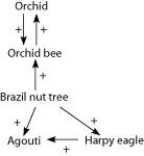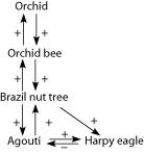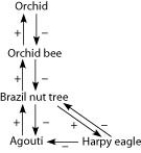Multiple Choice
Use the information to answer the following question.
The Brazil nut tree, Bertholletia excels (n = 17) , is native to tropical rain forests of South America. It is a hardwood tree that can grow to over 50 meters tall, a source of high-quality lumber, and a favorite nesting site for harpy eagles. As the rainy season ends, tough-walled fruits, each containing 8-25 seeds (Brazil nuts) , fall to the forest floor. Brazil nuts are composed primarily of endosperm. About $50 million worth of nuts are harvested each year. Scientists have discovered that the pale yellow flowers of Brazil nut trees cannot fertilize themselves and admit only female orchid bees as pollinators. The agouti (Dasyprocta spp.) , a cat-sized rodent, is the only animal with teeth strong enough to crack the hard wall of Brazil nut fruits. It typically eats some of the seeds, buries others, and leaves still others inside the fruit, which moisture can then enter and allow the remaining seeds to germinate.
Ecologists often build models to depict the relationships between organisms. In such models, an arrow is used to link two organisms in a relationship. The arrowhead is next to the organism that is affected. If the effect is positive, the arrow is labeled with (+) , and if negative, then the label is (-) . Which of the following models best illustrates the direct relationships of the Brazil nut tree and the other organisms associated with it?
A) 
B) 
C) 
D) 
Correct Answer:

Verified
Correct Answer:
Verified
Q30: Which of the following is a characteristic
Q44: Use the information to answer the following
Q45: Use the information to answer the following
Q46: Use the information to answer the following
Q47: What adaptations should one expect of the
Q50: Stamens, sepals, petals, carpels, and pinecone scales
Q51: Spruces and pines both have needlelike leaves,
Q52: Within a gymnosperm megasporangium, which of the
Q53: Use the information to answer the following
Q54: With respect to angiosperms, which of the